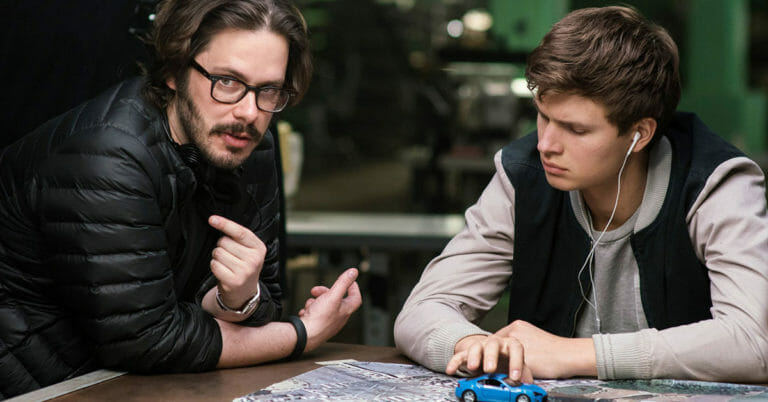By Valerie Kalfrin · November 9, 2018

People often imagine subtext like an iceberg: We might see a bit of the story up-front, but there’s a whole lot more going on underneath.
I like to think of subtext like filling: the sweet, nutty inside of a chocolate bar, or the cream within an eclair. The outside is delicious, but that extra part makes the treat much more satisfying.
Subtext runs throughout our lives—and through movies. Sure, people and characters sometimes say or do exactly what they mean, but more often there’s another layer in our dialogue and actions. This helps an audience connect with a story, regardless of genre, as they mull over what’s really happening in a scene, dissecting characters’ motives.
Script consultant Linda Seger, author of Writing Subtext: What Lies Beneath, says that subtext suggests true wants, desires, and goals. It also can show denial, attitudes, and cover-ups.
“Subtext is most apt to come through during crisis or at transition points in our lives—when a death occurs, a new job taken, at the start of a new relationship or the breakup of an old one—when the stakes are high and everything might rely on our saying and doing the right thing, even though we’re not sure what the ‘right thing’ is,” she writes.
Subtext makes your script feel more stylized and your characters more real, said screenwriter Steve Desmond, who teaches a webinar on the subject. There are times for blatant exposition or to go on the nose—a hugely emotional moment, such as, “Frankly, my dear, I don’t give a damn”—but to do so throughout makes dialogue sound fake.
An action-heavy blockbuster like Avengers: Infinity War, written by Christopher Markus and Stephen McFeely, might seem thin on subtext, but the film has it. Fans’ exposure to these heroes and their allies over a decade of other Marvel films imbues lots of smaller moments with deeper meaning. (Only mild spoilers here.)
Take the nickname that Thor (Chris Hemsworth) gives Rocket (the anthropomorphic CGI raccoon voiced by Bradley Cooper) after meeting him and the rest of the Guardians of the Galaxy early in the film. The Guardians think of their teammates like family. They’re fiercely loyal, even though they tease or annoy one another.
Rocket is as trigger-happy as he is cantankerous—and he’s fought for respect his whole life. In the prior two Guardians of the Galaxy films, he hates anyone referring to him as something “other,” whether a rodent, a raccoon, or a “trash panda,” one memorable dig from Star-Lord (Chris Pratt).
Thor repeatedly refers to Rocket as “rabbit”—and Rocket doesn’t correct him. Rocket says, “Rabbit?” once in consternation, then lets it be.
Thor first threads it through a compliment: “The rabbit is correct and clearly the smartest among you.”
Rocket doesn’t mind that—he boasts that he’s the best pilot—but subtext indicates something more. Rocket likes this demigod who can wield the power of thunder. He also feels compassion for Thor, whom the Guardians found amid the debris of a refugee ship from his home world. Outwardly, Rocket might prickle at someone thinking he’s warm and fuzzy, but he recognizes in Thor a lost soul who needs a friend.
The teen romance Love, Simon, based on the novel Simon vs. the Homo Sapiens Agenda and adapted by Elizabeth Berger and Isaac Aptaker, is full of subtext. Romantic comedies often are. But the film also is a sweet coming-out story, adding more layers to the interactions of Simon (Nick Robinson) and his friends.
Simon’s opening voiceover assures us he just like us, rattling off how many days he has until high-school graduation and what his family is like. “Except I have one huge-ass secret,” he finishes, gazing out the window at a hunky landscaper.
It turns out that Simon is writing to Blue, another closeted youth, who admitted under this pseudonym on a school blog that he was gay. Simon reaches out in reassurance, leading to more heartfelt messages. As Simon falls for Blue, his interactions with his peers take on subtext as he wonders who his pen pal is.
Is it Bram (Keiynan Lonsdale), the athlete who hosts a Halloween party? He recognizes that Simon is supposed to be musician John Lennon in his white suit and round glasses, which he even adjusts. What about Cal (Miles Heizer), the pianist accompanying the students’ tone-deaf performance of “Cabaret”? He jokingly waggles jazz hands at Simon after a particularly poor rehearsal. Then there’s Lyle (Joey Pollari), the waiter at the Waffle House who remembers Simon from class last year and greets him warmly at homecoming.
Simon’s dad (Josh Duhamel) is a rugged type who blurts out comments like, “How did that guy become The Bachelor? He’s so gay.” Neither he nor his wife (Jennifer Garner) notice how Simon shifts in his seat when that happens.
Meanwhile, Simon’s friends have their own hopeful love connections. When they stop for iced coffee while carpooling in the morning, soccer player Nick (Jorge Lendeborg Jr.) remembers that Abby (Alexandra Shipp), likes milk in hers. Abby is oblivious, as is Simon when his longtime pal Leah (Katherine Langford) shares that she doesn’t really date because she’s interested in only one person. Guess who that might be?
The 2017 crime caper Baby Driver, written by Edgar Wright, reveals its protagonist chafing to break free of a crime boss through subtext. Getaway driver Baby (Ansel Elgort) seems content in his own bubble, hidden behind sunglasses and earbuds whenever Doc (Kevin Spacey) talks to his crew. The music ostensibly drowns out his tinnitus, but it’s also an excuse for Baby to tune out everything until he finds something worth hearing—like the sweet singing of Debora (Lily James), the new waitress at the diner.
Baby stashes the money Doc pays him under the floorboards of the apartment that he shares with his foster father, Joseph (CJ Jones), who is deaf and uses a wheelchair. Doc summons the building’s elevator for Baby at one point and asks when he’ll move out of that joint. As Doc turns away, Baby takes the stairs.
Practice looking for subtext in your favorite films and TV shows. Then work up to writing it. It won’t be part of your first draft but rather one of the last steps as you polish and know your characters, theme, and story better, Desmond says.
Sprinkle subtext through your character or scene descriptions, Seger suggests. In Alvin Sargent’s script for Ordinary People, based on the novel by Judith Guest, Beth (Mary Tyler Moore) “prepares the table geometrically.” She likes things a certain way—a hint that she finds grief over her dead child much too messy.
Experiment with subtext through action. In To Have and Have Not, based on Ernest Hemingway’s novel and adapted by Jules Furthman and William Faulkner, Slim (Lauren Bacall) doesn’t blink or flinch when a man slaps her face—a clue to Harry (Humphrey Bogart) that she’s had a rough life before Martinique.
Then hone your dialogue. Desmond says he likes to write a journal entry or letter from each key character, just to shape their voices, then layer through the scenes what each character wants—and how they try to get it.
He suggests writing simple scenes as practice (say, a couple home on a Friday night but one wants to go out) and drawing on your memories. What really happened when you accomplished something, had an argument with a friend, or said you loved someone? What did you feel?
Tap into those feelings, and your subtext will grow richer—but don’t be intimidated if it takes a while to really sing, Desmond adds. “Love the journey. Love the experience of getting better as a writer. Love the experience of strengthening your story … and making it better and better.”
 Valerie Kalfrin is an award-winning crime journalist who now dives into fictional mayhem as an author (Quicklet on The Closer: Season 1), essayist, film critic, screenwriter, and emerging script consultant. She also writes for The Guardian, Bright Wall Dark Room, ScreenCraft, Hazlitt, Signature, and the blog for Final Draft, the top-rated screenwriting software used by the filmmaking industry. A member of Screenwriters of Tomorrow, she’s collaborated on short films and features, and she’s affiliated with the Tampa Bay Film Society. She lives in Florida. Find her online at valeriekalfrin.com.
Valerie Kalfrin is an award-winning crime journalist who now dives into fictional mayhem as an author (Quicklet on The Closer: Season 1), essayist, film critic, screenwriter, and emerging script consultant. She also writes for The Guardian, Bright Wall Dark Room, ScreenCraft, Hazlitt, Signature, and the blog for Final Draft, the top-rated screenwriting software used by the filmmaking industry. A member of Screenwriters of Tomorrow, she’s collaborated on short films and features, and she’s affiliated with the Tampa Bay Film Society. She lives in Florida. Find her online at valeriekalfrin.com.
Photo credit: Baby Driver and Pop Sugar
For all the latest from The Script Lab, be sure to follow us on Twitter, Facebook, and Instagram.